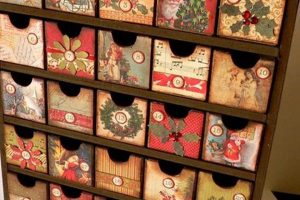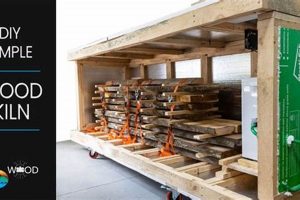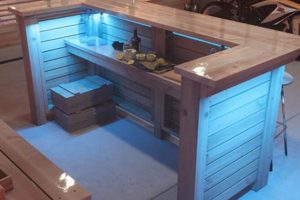The construction of storage solutions within wardrobes using lumber, undertaken as a do-it-yourself project, allows for customizable organization of clothing and accessories. This encompasses the planning, cutting, assembly, and installation of boards within an existing closet space to create tiered storage. For example, individuals may choose to install horizontal platforms at varying heights to accommodate folded garments, shoes, or storage bins, improving space utilization within a bedroom or dressing room.
Improved organization and efficient use of space are key advantages to this form of home improvement. Historically, homeowners have pursued such projects to tailor storage to their specific needs and preferences, optimizing functionality while often reducing clutter and enhancing the aesthetic appeal of a room. Furthermore, pursuing this type of project can represent a cost-effective alternative to purchasing pre-fabricated closet systems or engaging professional installers.
The following sections will delve into the essential aspects of planning, material selection, construction techniques, and installation best practices required for successful completion of this type of project. The discussion aims to equip individuals with the necessary knowledge to undertake this endeavor with confidence and achieve professional-looking results.
Essential Considerations for Closet Shelving Projects
The successful implementation of closet shelving involves careful planning and execution. Adherence to the following tips will enhance the structural integrity and aesthetic appeal of the finished product.
Tip 1: Precise Measurement is Critical: Accurately measure the closet interior dimensions before cutting any lumber. Account for wall irregularities and ensure that the shelving fits snugly without excessive gaps.
Tip 2: Material Selection Influences Durability: Select appropriate lumber based on anticipated load requirements. Solid wood, such as pine or oak, offers superior strength compared to composite materials, particularly when supporting heavy items.
Tip 3: Secure Fastening Prevents Collapse: Employ appropriate fasteners, such as screws or nails, and ensure they are of sufficient length and gauge to securely attach the shelving to the closet walls. Pilot holes prevent splitting and enhance the holding power of the fasteners.
Tip 4: Level Installation Ensures Stability: Use a level to ensure that the shelving is perfectly horizontal. Uneven shelving can lead to items sliding off and compromises the overall aesthetic appearance. Shims can be used to correct minor imperfections.
Tip 5: Consider Edge Treatment for Safety: Apply edge banding or round over sharp edges to prevent injuries and enhance the finished appearance. This is particularly important in areas where children may have access.
Tip 6: Proper Spacing for Usability: Plan shelving height based on anticipated storage needs. Leave adequate vertical space for folded clothing, shoes, or storage containers to ensure easy access and optimal utilization of the available space.
Tip 7: Reinforce for Heavy Loads: When storing heavy items, install additional support brackets or vertical dividers to distribute the weight evenly and prevent sagging. This will extend the lifespan of the shelving and maintain its structural integrity.
Adhering to these considerations will result in a robust, functional, and visually appealing shelving solution tailored to specific storage requirements. Attention to detail during each stage of the process is crucial for achieving professional results.
The subsequent sections will provide more in-depth guidance on specific techniques and advanced considerations relevant to closet shelving installation.
1. Accurate Measurements
Accurate measurements are foundational to successful wood closet shelving projects. Precise dimensions directly impact the functionality, stability, and aesthetic appeal of the final installation. Errors in measurement can lead to ill-fitting shelves, structural instability, and an overall compromised outcome, necessitating rework and potentially wasting materials.
- Determining Interior Dimensions
This encompasses measuring the width, depth, and height of the closet space. Multiple measurements should be taken at different points along each dimension to account for any irregularities in the walls, floor, or ceiling. Failure to account for variations can result in shelves that are either too large to fit or too small and unstable. For instance, a closet wall that is not perfectly square may require adjustments to shelf dimensions to ensure a flush fit. The implications of inaccurate measurements at this stage ripple through the entire project.
- Calculating Shelf Length and Depth
Shelf dimensions must be calculated based on the desired storage capacity and the structural integrity of the chosen material. Overly long shelves without sufficient support may sag under the weight of stored items. Depth must be considered in relation to the items to be stored, as shelves that are too shallow may not adequately accommodate clothing or storage containers. An example of inadequate planning would be constructing shelves too short for folded sweaters or too shallow to hold storage boxes, negating the benefits of the installed shelving.
- Accounting for Obstructions and Hardware
Existing features within the closet, such as light fixtures, electrical outlets, or molding, must be factored into the measurements. Furthermore, the dimensions of any hardware, such as shelf supports or mounting brackets, must be considered to ensure proper fit and alignment. For example, forgetting to account for the thickness of shelf support brackets can result in shelves that protrude beyond the desired depth, interfering with the closet door or adjacent fixtures. Overlooking these details can disrupt the planned layout and require modifications.
- Verifying Measurements Before Cutting
Before cutting any lumber, it is imperative to double-check all measurements and mark the cutting lines clearly and accurately. A simple mistake in measurement at this stage can lead to significant material waste and project delays. A practical example would be re-measuring and verifying dimensions with a tape measure before operating a saw, ensuring the cut pieces align with the design. This step provides a safeguard against preventable errors.
In summation, accurate measurements are not merely a preliminary step but a fundamental requirement for successful wood closet shelving projects. Precision throughout the measuring and cutting process directly influences the functionality, stability, and aesthetic appeal of the final installation. Diligence in obtaining and verifying measurements minimizes the risk of errors, reduces material waste, and ensures a satisfying outcome.
2. Material Selection
The choice of materials significantly influences the structural integrity, longevity, and aesthetic quality of closet shelving projects. Careful consideration must be given to the properties of different wood types and composite materials to ensure they meet the specific demands of the application.
- Solid Wood Varieties
Solid wood options such as pine, oak, and maple offer varying degrees of strength, durability, and aesthetic appeal. Pine is a cost-effective choice for lighter loads and painted finishes, while oak provides superior strength and a more premium appearance. Maple is known for its hardness and resistance to scratches, making it suitable for high-use areas. The selection of a specific wood variety should align with the anticipated load, desired finish, and budget constraints. For example, shelving intended to support heavy storage boxes would benefit from the increased strength of oak, whereas a light load bearing shelf could be constructed from cost effective pine.
- Engineered Wood Products
Engineered wood products, including plywood, particleboard, and MDF (medium-density fiberboard), offer alternative solutions with varying properties and cost points. Plywood provides good strength and resistance to warping, making it a suitable choice for shelving. Particleboard, while more affordable, is less resistant to moisture and may require additional support. MDF offers a smooth surface ideal for painting but is generally less structurally sound than plywood. The selection of an engineered wood product requires careful evaluation of its load-bearing capacity, resistance to moisture, and suitability for the intended finish. For instance, using MDF in a high-humidity environment without proper sealing could result in swelling and degradation.
- Load-Bearing Capacity Considerations
The weight that the shelves will bear is a critical factor in material selection. Different materials possess varying degrees of strength and resistance to bending or sagging under load. The spacing between shelf supports must be adjusted based on the chosen material and the anticipated weight. Shelving intended for heavy items, such as books or storage containers, requires stronger materials and closer support spacing to prevent structural failure. A practical example is reinforcing shelves made of particleboard with additional supports to prevent sagging under the weight of stored items.
- Finish and Aesthetic Preferences
The desired finish and aesthetic appearance play a significant role in material selection. Some wood species lend themselves well to staining and varnishing, showcasing the natural grain, while others are better suited for painting. Engineered wood products such as MDF provide a smooth, uniform surface ideal for painted finishes. The choice of material should align with the overall design aesthetic and the desired level of visual appeal. For example, using oak shelving with a clear varnish can enhance the natural beauty of the wood grain, while MDF shelving painted with a bright color can create a more contemporary look.
The interplay between material strength, cost, and aesthetic considerations dictates the optimal choice for wood closet shelving installations. Careful evaluation of these factors is essential for achieving a functional, durable, and visually pleasing storage solution.
3. Secure Fastening
Secure fastening constitutes a critical component of successful wood closet shelving construction. Inadequate or inappropriate methods of attachment directly compromise the structural integrity and long-term stability of the shelving unit. The connection between the shelving and its supporting structure typically the closet walls is the primary determinant of its load-bearing capacity and resistance to collapse. Selecting and implementing appropriate fasteners, such as screws, nails, or specialized hardware, is therefore paramount. Failure in this area leads directly to sagging shelves, potential material failure, and a compromised storage solution. For example, attempting to support heavy items on shelves attached solely with brad nails is likely to result in failure over time. Conversely, employing appropriately sized and spaced screws, coupled with proper anchoring techniques, ensures a robust and reliable shelving system.
The type of fastener selected must be appropriate for both the shelving material and the wall construction. Drywall, for instance, requires the use of anchors to provide sufficient holding power for screws. Solid wood walls allow for direct screw attachment, while concrete or brick walls necessitate specialized masonry fasteners. The length and gauge of the fastener are also critical considerations. Insufficiently long screws may not penetrate deeply enough to provide adequate support, while excessively long screws can protrude through the wall or split the wood. Furthermore, the spacing of fasteners must be sufficient to distribute the load evenly. Insufficiently spaced fasteners create stress concentrations, increasing the likelihood of failure. An example of best practice is the use of stud finders to locate wall studs for direct screw attachment, thereby maximizing holding power. In situations where stud attachment is not feasible, high-quality drywall anchors or toggle bolts are necessary to provide adequate support.
In summary, secure fastening is not merely a detail but rather a fundamental principle underpinning the success and safety of any wood closet shelving project. Proper selection, placement, and installation of fasteners are essential to ensure the long-term stability, load-bearing capacity, and overall functionality of the shelving unit. Overlooking this aspect introduces significant risks of failure, potentially leading to property damage or personal injury. A thorough understanding of fastening techniques and material properties is therefore crucial for any individual undertaking this type of project.
4. Level Installation
Level installation is a non-negotiable aspect of closet shelving construction. Deviations from a true horizontal plane introduce instability, compromise aesthetic appeal, and diminish overall functionality. Ensuring shelves are perfectly level requires meticulous attention to detail throughout the installation process.
- Structural Integrity and Load Distribution
Shelves installed out of level experience uneven weight distribution. The higher side bears a disproportionate load, potentially leading to sagging, warping, or even complete structural failure over time. A real-world example would be observing books or items naturally migrating toward the lower end of an unlevel shelf, further exacerbating the imbalance. The implications are a reduced lifespan for the shelving unit and a compromised storage solution.
- Aesthetic Considerations
Visually, unlevel shelves create a jarring and unprofessional appearance. Even slight deviations from horizontal are readily perceptible, detracting from the overall aesthetic appeal of the closet space. For example, the eye is naturally drawn to the sloping line of an unlevel shelf, making it appear carelessly constructed. The implications are a devalued sense of craftsmanship and a diminished visual harmony within the storage area.
- Functional Implications for Stored Items
Unlevel shelving directly impacts the usability of the storage space. Items placed on sloping shelves may slide, tip over, or become difficult to access. Clothing stacks may become unstable, and containers may shift or fall. The implications are increased risk of damage to stored items and a general sense of disorganization. Imagine wine bottles rolling off a slightly tilted wine rack this can happen to items inside closet as well if not installed properly.
- Mitigation Techniques and Tools
Achieving level installation requires the use of appropriate tools, such as spirit levels, laser levels, and shims. Spirit levels provide a visual indication of horizontal alignment, while laser levels offer increased accuracy and extended range. Shims are thin pieces of material used to correct minor deviations and achieve a perfectly level surface. A practical mitigation strategy is the use of a long spirit level spanning the entire shelf length, coupled with shims placed strategically beneath the shelf supports. This ensures accurate leveling across the entire shelf surface.
In conclusion, level installation transcends mere aesthetics; it is a fundamental principle that directly impacts the structural integrity, functionality, and overall value of closet shelving endeavors. Diligence in achieving a perfectly level surface is an investment in the longevity and usability of the storage solution.
5. Edge Treatment
Edge treatment, within the context of constructing closet shelving from lumber, serves a dual purpose: mitigating safety hazards and enhancing the overall aesthetic quality of the finished product. The raw edges of cut lumber, particularly plywood or MDF, present a risk of splinters and abrasions. Furthermore, exposed edges often lack visual appeal, detracting from the professional appearance of the installation. Therefore, implementing appropriate edge treatment techniques is a critical step in completing the shelving project safely and effectively. The selection of edge treatment methods has an effect on the longevity and durability of the shelves.
Several methods exist for treating the edges of wooden closet shelves. Edge banding, typically made of wood veneer, PVC, or melamine, provides a clean, finished look and protects against moisture absorption. This process involves applying the banding to the exposed edge with adhesive and trimming any excess material. Alternatively, solid wood trim can be attached to the shelf edges using glue and fasteners, creating a more substantial and decorative border. A third option involves rounding over the sharp edges using a router with a rounding-over bit, producing a smooth, tactile surface. The choice of method depends on factors such as the type of lumber, the desired aesthetic, and the level of skill and equipment available. For instance, applying solid wood trim to the front edges of shelving made from plywood can enhance the appearance of a premium, custom-built closet system, while edge banding represents a more cost-effective and efficient solution for shelves made from MDF.
Effective edge treatment elevates the quality and safety of shelves. It minimizes the risk of injury from sharp edges or splinters, particularly important in households with children. Simultaneously, it contributes to a more polished and professional appearance, enhancing the overall visual appeal of the closet space. Moreover, edge treatment can improve the durability of shelves by protecting the core material from moisture and impact damage. In summary, this stage represents a crucial investment in the longevity, functionality, and aesthetic value of custom-built closet storage solutions. Without proper edge treatment, the benefits of careful planning and precise execution are diminished, resulting in a compromised final product.
6. Spacing
Effective utilization of closet space in construction hinges on meticulous planning. The vertical distance between shelves, and the horizontal distance between vertical supports, directly determines the utility and efficiency of a storage system. Inadequate spacing restricts accessibility and reduces storage capacity, while excessive spacing wastes valuable volume. This aspect requires careful consideration of the items to be stored and the structural limitations of the materials used. A shelf system designed to accommodate folded sweaters necessitates less vertical space than one intended for hanging garments or storing tall boots. An oversight in this planning phase negates the benefits of a custom system.
Consider the practical application of shelf spacing in a linen closet. Too little space between shelves compresses stacks of towels and sheets, hindering easy selection and removal. Conversely, excessive spacing results in wasted vertical volume. A more effective approach involves measuring the typical height of folded linens and adjusting shelf spacing accordingly. Likewise, in a wardrobe designed for clothing, the vertical distance between shelves influences the ability to store shoes, handbags, or folded items. Strategic placement of vertical dividers provides support and creates distinct zones within the storage area, optimizing functionality and preventing items from toppling over. An example of poor practice includes uniform spacing across all shelves, failing to account for the varied heights of stored items.
The careful planning of shelf dimensions and support placement is integral to successful closet construction. Failure to account for individual requirements undermines the purpose of creating a custom solution. Optimized spacing maximizes storage capacity, ensures easy access, and contributes to an organized storage system. Adjustments to spacing account for potential limitations due to material strength and weight to prevent sagging or potential collapse. The strategic approach considers not only the immediate storage needs but also potential long-term demands. The result delivers a tailored and practical solution that will remain effective over time.
Frequently Asked Questions
The following addresses common inquiries regarding the design, construction, and installation of closet storage solutions from lumber. These questions aim to clarify key aspects of such projects and provide guidance for a successful outcome.
Question 1: What is the optimal lumber species for shelving intended to support heavy items?
Hardwoods such as oak or maple offer superior load-bearing capabilities compared to softwoods like pine. The selection should align with the anticipated weight of stored items and desired aesthetic.
Question 2: How can sagging shelves be prevented over time?
Implementing adequate support structures is crucial. This involves reducing the distance between shelf supports, utilizing thicker lumber, or incorporating vertical dividers to distribute weight evenly.
Question 3: What is the proper method for attaching shelving to drywall?
Drywall alone does not provide sufficient holding power. Specialized anchors, such as toggle bolts or heavy-duty drywall anchors, are required to ensure secure attachment.
Question 4: How can a perfectly level installation be achieved?
Employ a spirit level or laser level to verify horizontal alignment. Shims can be used to correct minor imperfections and ensure a consistently level surface.
Question 5: Is edge banding necessary for all lumber types?
Edge banding is particularly recommended for plywood and MDF, as it conceals the exposed core and prevents moisture absorption. Solid wood edges can be rounded over for safety and aesthetic purposes.
Question 6: What considerations are relevant when determining shelf spacing?
Vertical spacing should be dictated by the height of anticipated items. Adequate clearance ensures easy access and prevents overcrowding. Standardized spacing may not be suitable for all storage needs.
In summary, careful attention to material selection, support structures, fastening techniques, leveling, edge treatment, and spacing is essential for a successful and enduring shelving installation.
The subsequent sections will delve into advanced techniques and troubleshooting strategies to further enhance the quality and longevity of your closet shelving project.
Conclusion
The preceding discussion provides a comprehensive overview of wood closet shelving DIY, encompassing planning, material selection, construction techniques, and essential considerations. Attention to detail in measurement, fastening, and leveling ensures a functional and aesthetically pleasing storage solution. The selection of appropriate materials and edge treatment enhances longevity and safety.
Successfully executed storage installations offer optimized space utilization and improved organization. Individuals contemplating this project are advised to thoroughly assess their storage requirements, plan diligently, and adhere to the principles outlined to achieve a durable and effective system.







